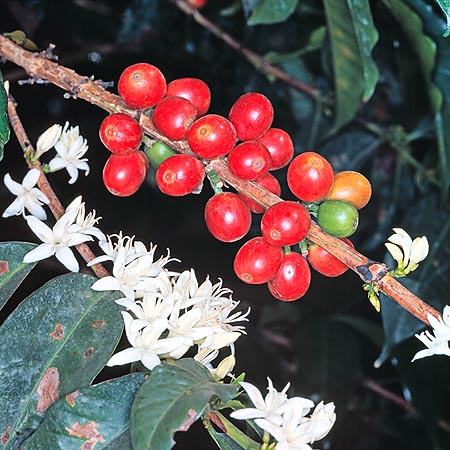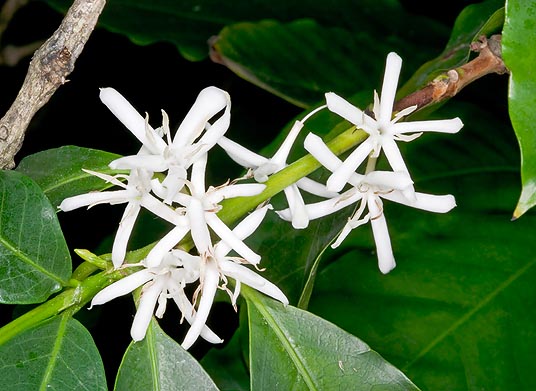Family : Rubiaceae

Text © Pietro Puccio

English translation by Mario Beltramini

Coffea arabica © Giuseppe Mazza
The Coffea arabica L. (1753) is native to the highlands of Sudan, Kenya and Ethiopia.
The name of the genus comes from the Italian caffè, which comes from the Turkish kahvé, corruption of the Arabic word qahwa, which originally was indicating a fermented dark red beverage and later the drink obtained from the roasted seeds of the plant; the Latin name of the species “Arabica” = belonging to Arabia, refers to the place which was thought to be its original one.
Common names: “caffé”, “pianta del caffé” (Italian); “quahwah”, “qahwa”, “elive” (Arabic); “kahvé” (Turkish); “Arabian coffee”, “Arabica coffee”, “coffee”, “coffeetree” (English); “caféier d’Arabia”, “café arabica”, “caféier commun” (French); “arabicakoffie”, “koffie”, “koffiestruik” (Dutch); “Arabicakaffee”, “Arabischer Kaffeebaum”, “Arabischer Kaffeestrauch”, “Bergkaffee Kaffeestrauch” (German); “caféeiro”, “café”, “cafeiro” (Portuguese); “cafeto arábico”, “cafeto de Arabia”, “árbol del café”, “cafeto” (Spanish).
Shrub or small evergreen tree, tall up to about 5-7 metres, it shows opposite leaves of an almost elliptical shape, of an intense glossy green colour, long up to 15 cm and 7 broad; the flowers, in axillar groups, are about 20 mm wide, of a bright white colour and slightly perfumed. The fruits, containing usually two seeds, are ovoid drupes, about 15 mm long, of green colour, turning, during the ripening process which lasts about 9 months, at the beginning to the yellow, then to red and finally to black. It usually reproduces by seed, from which plants able to fructify already by the third, forth year of age can be obtained.
The importance of this plant in the world economy is well known, the arabica species itself covers the 70% of the world production of coffee, and the effects of the drink, which are obtained from its roasted seeds, are also well known, and their counter-indications due to an excessive consumption.
From the botanical point of view, it is interesting to observe that the arabica has a characteristic which rarely happens in nature: it is an allotetraploid plant, the only one in the genus Coffea which counts about a hundred species, that is, it holds the chromosome equipment of two different diploid plant (a diploid plant holds two homologous copies of each chromosome) totalling 44 chromosomes, furthermore, contrarily to almost all other plants of the genus, is auto-fertile. The genetic studies have led to the conclusion that the Coffea arabica comes from a crossing between two diploid species of the same genus, which have been identified in the canephora (forefather) and in the eugenioides (foremother), both auto-sterile.

Flowers of Coffea arabica © Giuseppe Mazza
The intensive cultivation for the production of coffee have faded into the background, for long time, the undoubted ornamental characteristics of the plant; its commercialization has begun only in relatively recent times, in particular in Europe, as pot plant for indoor decoration. In fact, the plant, outside from tropical, subtropical and warm-temperate areas (in sheltered location), can be cultivated only in a protected space, as it does not bear, if not for a very short time, temperatures just under the 0°C.
Synonyms: Coffea arabica f. abyssinica A.Chev. (1942); Coffea arabica var. mauritiana (Lam.) Willd. (1797); Coffea arabica var. polysperma Burck, (1890); Coffea arabica var. amarella A.Froehner, (1898); Coffea arabica var. intermedia A.Froehner (1898); Coffea arabica var. stuhlmannii A.Froehner (1898); Coffea arabica var. rachiformis (Baill.) A.Froehner (1898). Coffea arabica var. maragogype A.Froehner (1898); Coffea arabica var. angustifolia (Roxb.) Miq. ex A.Froehner (1898); Coffea arabica var. humblotiana (Baill.) A.Froehner (1898); Coffea arabica var. straminea Miq. ex A.Froehner (1898); Coffea arabica var. angustifolia Cramer (1907); Coffea arabica var. rotundifolia Ottol. ex Cramer (1907); Coffea arabica var. murta Lalière (1909); Coffea arabica var. pendula Cramer (1913); Coffea arabica var. purpurascens Cramer (1913); Coffea arabica var. bullata Cramer (1913); Coffea arabica var. mokka Cramer (1913); Coffea arabica var. typica Cramer (1913); Coffea arabica var. columnaris Ottol. ex Cramer (1913); Coffea arabica var. erecta Ottol. ex Cramer (1913); Coffea arabica var. monosperma Ottol. & Cramer (1913); Coffea arabica var. variegata Ottol. ex Cramer (1913); Coffea arabica var. pubescens Cif. (1937); Coffea arabica var. longistipulata Cif. (1937); Coffea arabica var. brevistipulata Cif. (1937); Coffea arabica var. culta A.Chev. (1942); Coffea arabica var. cultoides A.Chev. (1942); Coffea arabica var. latifolia A.Chev. (1942); Coffea arabica var. myrtifolia A.Chev. (1942); Coffea arabica var. sundana (Miq.) A.Chev. (1947).
→ To appreciate the biodiversity within the RUBIACEAE family please click here.
